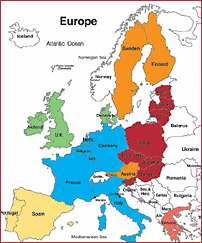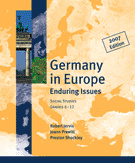Topic 1: Germany’s Changing Position in Europe and the World

 | Focus Question #3 |
the creation of the European Union?
- What were the steps in the creation of the European Union?
- How did the Cold War impact the creation of the European Union?
- What are the opportunities/consequences of the new Germany?
Alignment to National Standards
Background Information
When World War II ended, the Soviet Union, fearful of future invasions from the West, established control over much of Eastern Europe, and the United States and Great Britain, fearful of Soviet expansion, opposed the Soviets on many international policy issues. The conflict among the former allies of World War II, which became known as the Cold War, lasted for almost a half century. It left many to fear that a third World War, a totally devastating nuclear war, would destroy western civilization and perhaps completely doom the human race. With dramatic events, such as the fall of the Berlin Wall and the Soviet Union collapsing as a country, the Cold War came to an end in 1991. Much of the world celebrated. Perhaps the world had moved into a time when at last there would be peace, but we know from history that the end of conflict rarely leads to smooth results.
After German unification in 1990, work began on the Maastricht Treaty that went into effect January 1, 1993, transforming the European Community into a European Union. On May 1, 2004, the membership was expanded to include the nations of Cypres, Malta, the Czech Republik, Estonia, Hungary, Latvia, Lithuania, Poland, Slovakia, and Slovenia. This coming together of the countries of Europe was a result of the desires of many people after World War II to never have another devastating conflict such as the one they had just experienced. Cooperation and interdependence would be a way of avoiding such conflicts in the future. The Cold War was at and end and Europe now looks forward to an era of peace and cooperation.
Note: Use Slide #5: Topic 1, Lesson 3 (Member Nations of the European Union with Overlay) to show the growth of the European Union.

Slide #5:
Essential Content
Note: The following words/concepts are essential to an understanding of this lesson. Put the words on your Word Wall and use them in context as you teach the lesson.
- Conflict
- Cold War
- Truman Doctrine
- Marshall Plan
- Berlin Blockade
- Berlin Airlift
- Berlin Wall
- German Democratic Republic
- German Federal Republic
- Shuman Plan
- European Atomic Energy Community (EURATOM)
- European Community
- Maastricht Treaty
- Cold War

 Printable PDF
Printable PDF